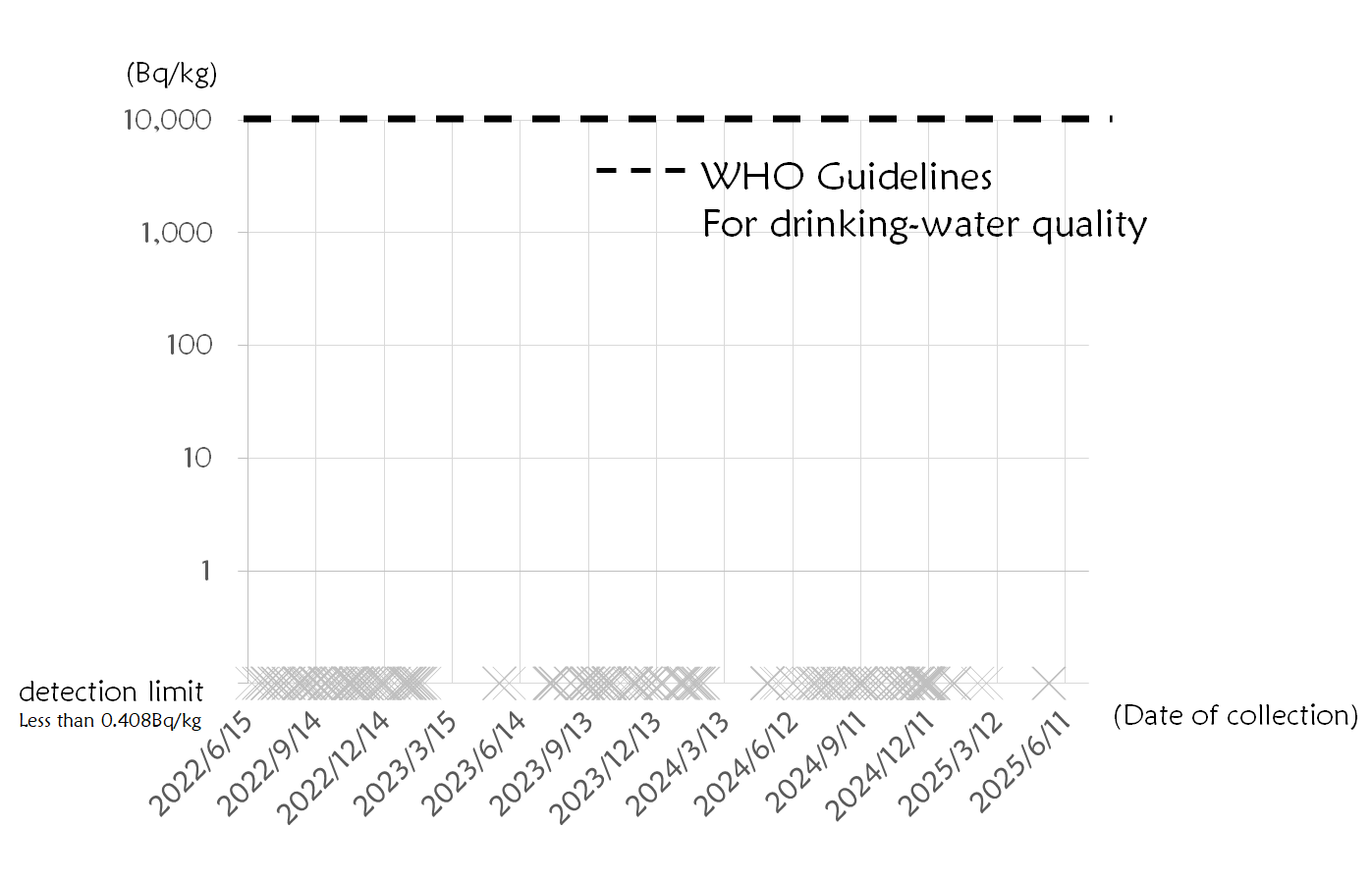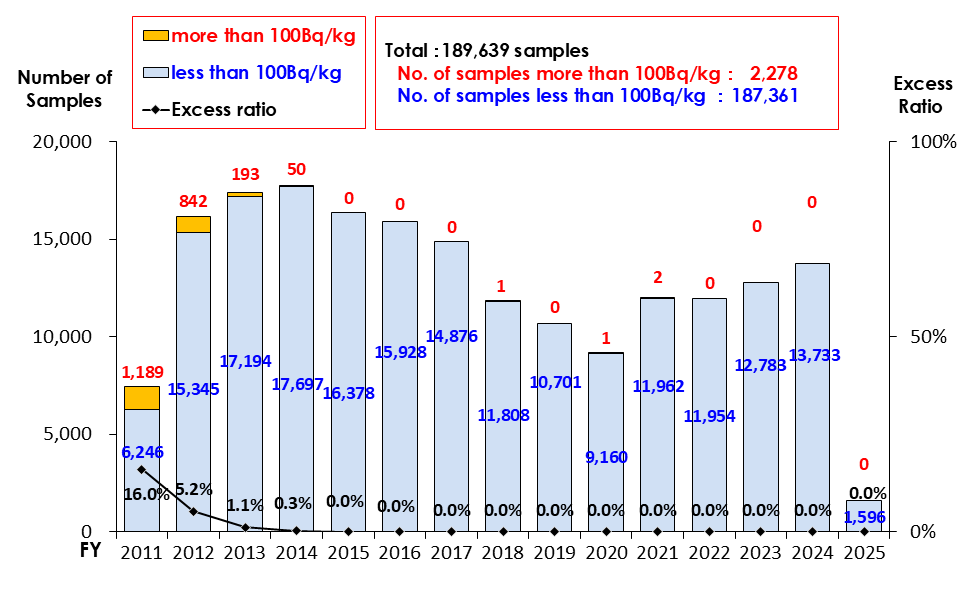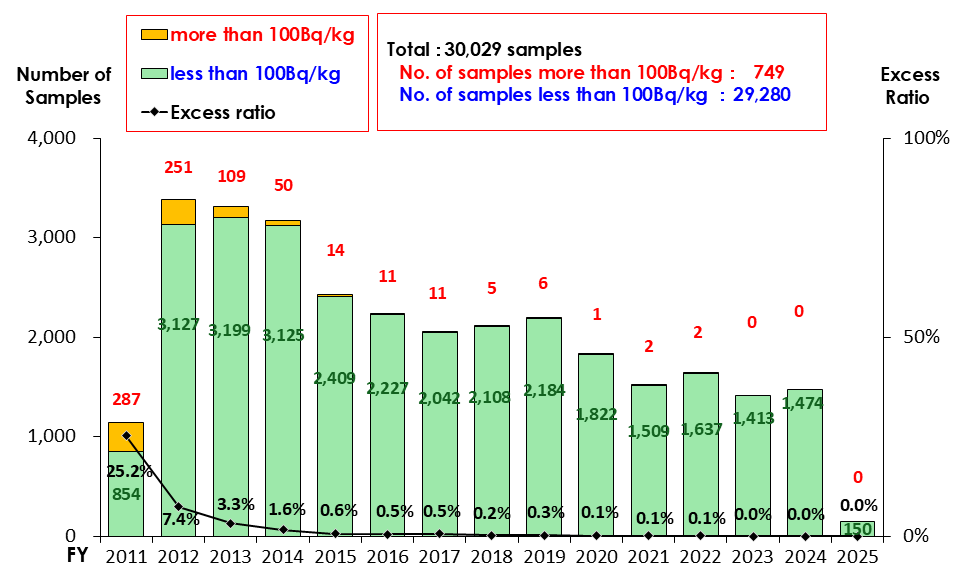Results of the monitoring on radioactivity level in fishery products
|
In accordance with the “Concepts of Inspection Planning and the Establishment and Cancellation of Items and Areas to which Restriction of Distribution and/or Consumption of Foods concerned Applies(PDF : 238KB)” the Fisheries Agency, in cooperation with the relevant prefectural governments and organizations, has been regularly conducting monitoring of radioactive materials in the fishery products in Fukushima and adjacent prefectures since the accident of Fukushima Daiichi Nuclear Power Station (FDNPS) of Tokyo Electric Power Company following the Great East Japan Earthquake in 2011. |
Contents
1.Tritium ( Rapid analysis method ![]() / Internationally recognized method
/ Internationally recognized method ![]() )_2.Radioactive cesium(Cs134+Cs137) _3.Multiple radionuclides(Sr, Cs, I, Pu, Am) _4.Data source_5.Reference
)_2.Radioactive cesium(Cs134+Cs137) _3.Multiple radionuclides(Sr, Cs, I, Pu, Am) _4.Data source_5.Reference
1. Tritium
1-1.Marine fish species
1-1-1.Rapid analysis method(as of 18 July, 2025)
The Fisheries Agency samples at the same location as T-S3 (about 4 km north-northeast of the discharge outlet) and T-S8 (about 5 km south-southeast of the discharge outlet) (circled in red in the figure on the right), where TEPCO conducts sampling.
<Rapid analysis results as of 18 July, 2025>
T-S3:Latitude 37°27'30"N Longitude 141°04'44"E T-S8:Latitude 37°23'00"N Longitude 141°04'44"E WHO Guidelines For drinking-water quality:10,000Bq/L |
 Modified the materials of the Fukushima Prefectural Fishermen's Association Chairman's Meeting |
 |
The samples used for rapid analysis are sampled using a fishing method called "gillnets," in which fish are caught by piercing or entangling them in the nets. |
Detailed survey results are available in Excel and PDF below.
After number 15, the result is after the discharge of ALPS treated water.
- Analysis Results for FY2023~2025
1-1-2.Internationally recognized method(as of 23 June, 2025)
- Analysis Results for FY2022~2025
| Analysis Results for Fishery Products |
 |
2. Radioactive cesium(Cs134+Cs137)
Annual monitoring results of fishery products(as of 27 May, 2025)
At a total of 219,668 fishery product samples has been monitored since the FDNPS accident. The result represents a significant trend that the radioactive cesium excess ratio has decreased and recently very few fishery products exceed the Japanese maximum level (100Bq/kg). Shipment restrictions have been lifted for the great majority of marine fish species and thereby they are traded at the market without any radiological restrictions in Japan.
Marine fish species |
Freshwater fish species |
Note: This graph is a compilation of the monitoring results of Japan Fisheries Research and Education Agency, the prefecture, and fishery organizations.
Detailed survey results are available in Excel and PDF below.
- Press releases in March 2011~May 2025(EXCEL : 16,478KB)
- Press releases in March 2011~May 2025(PDF : 28,372KB)
Note: This data sheet is a compliation of monitoring results released by prefectual government
3. Multiple radionuclides(Sr, Cs, I, Pu, Am)
- Monitoring results of radionuclides in fisheries products conducted by Fisheries Research Agency(PDF : 800KB)(as of 17 April, 2025)
Note: This data sheet is a compliation of monitoring results released by Japan Fisheries Research and Education Agency
4.Data source
This data is incorporated in the results of above Section1 and 2.
Japan Fisheries Research and Education Agency(Japanese only)
Individual monitoring results released by prefectural governments
|
Iwate |
|||
|
Akita |
Yamagata |
Ibaraki |
|
|
Tochigi |
Saitama |
Chiba※1 |
|
|
Tokyo |
Kanagawa※2 |
Niigata |
Yamanashi |
※1 Fish landed at ports in Chiba prefecture, is monitored by Fishers' Cooperatives and the results are published by Chiba prefecture.
※2 Website of Kanagawa prefecture includes results of monitoring conducted by municipalities in Kanagawa prefecture (such as Yokohama city).
Individual monitoring results released by fisheries associations
- National Federation of Fisheries Co-operative Associations(Japanese only)
- National Saury Fishery Association(Japanese only)
- National Surimi Manufacturers Assiciation(Japanese only)
5.Reference
Summary for understanding the monitoring of radioactive materials in fishery products(As of March 2024)
 English |
 Simplified Chinese |
 Traditional Chinese |
 Korean |
 Thai |
Report on the monitoring of radionuclides in fishery products(As of October 2017)
This report is compiled by the Fisheries Agency of Japan to provide a comprehensive evaluation of the results of radionuclides monitoring conducted on fishery products in the years since the Fukushima Daiichi Nuclear Power Station accident.





